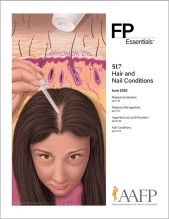
This clinical content conforms to AAFP criteria for CME.
The goals of management in patients with nonscarring and scarring alopecias are stabilization of hair loss and improvement in hair density. Management often is a lengthy process that requires months to years. Patients may present with more than one cause of alopecia, so management may need to address more than one process. Goals for alopecia management are diagnosis-specific. Physicians should set patient expectations early about the potential for hair regrowth with treatment. Patients should be counseled about hair care practices, personal care products, vitamins, and use of hairstyling devices. Management options such as topical and oral drugs and intralesional injections should be considered based on the diagnosis and the level of evidence supporting their use. Hair transplantation may be an option for select patients. There are more evidence-based guidelines for initial management of nonscarring alopecias than for scarring alopecias. Because of the relative rarity of scarring alopecias, there is a lack of large data sets on which to base guidelines.
Case 2. CA is a 28-year-old woman who comes to your office with concerns about significant shedding characterized by large quantities of hair falling out during the day, particularly in the shower. She is 4 months postpartum and generally is healthy. Laboratory test results were normal during the pregnancy. On physical examination, you find no erythema or scaling of the scalp, and the eyelashes and eyebrows are intact. A hair pull test is positive and produces numerous telogen hairs.
Already a subscriber?
Log In
Subscribe
From $350- Immediate, unlimited access to FP Essentials content
- 60 CME credits/year
- AAFP app access
- Print delivery available
Edition Access
$44- Immediate, unlimited access to this edition's content
- 5 CME credits
- AAFP app access
- Print delivery available
Interested in AAFP membership? Learn more
Learn More
